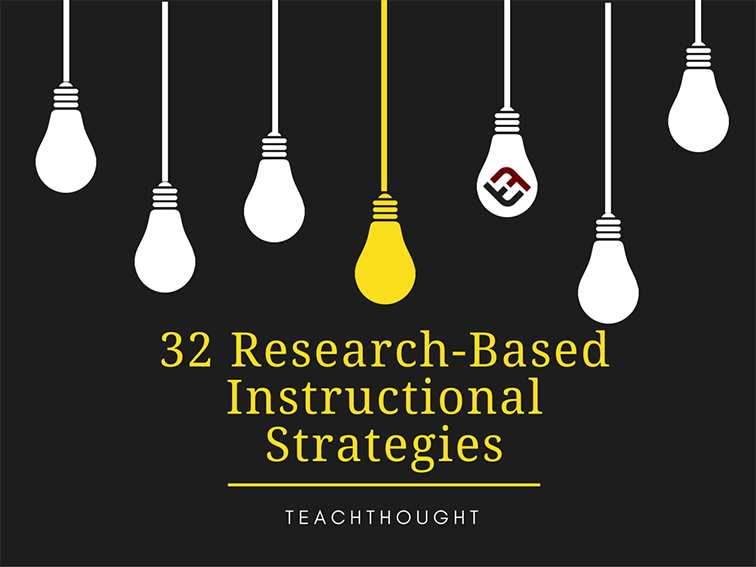
32 Research-Based Instructional Strategies For Teachers
by TeachThought Staff
You want to teach with what’s been proven to work. That makes sense.
In the ‘data era’ of education that’s mean research-based instructional strategies to drive data-based teaching, and while there’s a lot to consider here we’d love to explore more deeply, for now we’re just going to take a look at the instructional strategies themselves.
A post is not the best way to share this kind of information, honestly. A video for each one might be better, so maybe a YouTube channel? Or a book, as Hattie and Marzano and others have done. Professional development may also work–take 12 strategies or so and work with teachers to integrate them into different kinds of lessons may be useful. (See Hattie’s Index Of Effect Sizes.)
But upside to sharing this information as a post is that it can act a starting point to research the above, which is why we’ve tried to include links, related content, and suggested reading for many of the strategies, and are trying to add citations for all of them that reference the original study that demonstrated that strategy’s effectiveness. (This is an ongoing process.)
How should you use a list like this? In 6 Questions Hattie Didn’t Ask, Terry Heick wondered the same.
“In lieu of any problems, this much data has to be useful. Right? Maybe. But it might be that so much effort is required to localize and recalibrate it a specific context, that’s it’s just not–especially when it keeps schools and districts from becoming ‘researchers’ on their own terms, leaning instead on Hattie’s list. Imagine ‘PDs’ where this book has been tossed down in the middle of every table in the library and teachers are told to ‘come up with lessons’ that use those strategies that appear in the ‘top 10.’ Then, on walk-throughs for the next month, teachers are constantly asked about ‘reciprocal teaching’ (.74 ES after all). If you consider the analogy of a restaurant, Hattie’s book is like a big book of cooking practices that have been shown to be effective within certain contexts: Use of Microwave (.11 ES) Chefs Academic Training (.23 ES), Use of Fresh Ingredients (.98). The problem is, without the macro-picture of instructional design, they are simply contextual-less, singular items.”
In short, these instructional strategies have been demonstrated to, in at least one study, be ‘effective.’ As implied above, it’s not that simple–and it doesn’t mean it will work well in your next lesson. But as a place to begin taking a closer look at what seems to work–and more importantly how and why it works–feel free to begin your exploring with the list below.
32 Research-Based Instructional Strategies For Teachers
1. Setting Objectives
2. Reinforcing Effort/Providing Recognition
3. Cooperative Learning
4. Cues, Questions & Advance Organizers
5. Nonlinguistic Representations (see Teaching With Analogies)
6. Summarizing & Note Taking
7. Identifying Similarities and Differences
8. Generating & Testing Hypotheses
9. Instructional Planning Using the Nine Categories of Strategies
10. Rewards based on a specific performance standard (Wiersma 1992)
11. Homework for later grades (Ross 1998) with minimal parental involvement (Balli 1998) with a clear purpose (Foyle 1985)
14. Provide opportunities for student practice
15. Individualized Instruction
16. Inquiry-Based Teaching (see 20 Questions To Guide Inquiry-Based Learning)
See also The 40 Best Classroom Management Apps & Tools
17. Concept Mapping
18. Reciprocal Teaching
19. Promoting student metacognition (see 5o Questions That Promote Metacognition In Students)
20. Developing high expectations for each student
21. Providing clear and effective learning feedback (see 13 Concrete Examples Of Effective Learning Feedback)
22. Teacher clarity (learning goals, expectations, content delivery, assessment results, etc.)
23. Setting goals or objectives (Lipset & Wilson 1993)
24. Consistent, ‘low-threat’ assessment (Bangert-Drowns, Kulik, & Kulik 1991; Fuchs & Fuchs 1986)
25. Higher-level questioning (Redfield & Rousseau 1981) (see Questions Stems For Higher Level Discussion)
26. Learning feedback that is detailed and specific (Hattie & Temperly 2007)
27. The Directed Reading-Thinking Activity (Stauffer 1969)
28. Question-Answer Relationship (QAR) (Raphael 1982)
29. KWL Chart (Ogle 1986)
30. Comparison Matrix (Marzano 2001)
31. Anticipation Guides (Buehl 2001)
32. Response Notebooks (Readence, Moore, Rickelman, 2002)
Sources: Marzano Research; Visible Learning; http://www.sde.ct.gov/sde/lib/sde/pdf/curriculum/section7.pdf ; 32 Research-Based Instructional Strategies